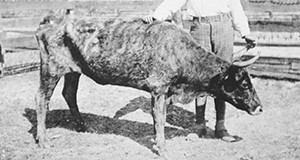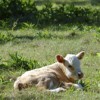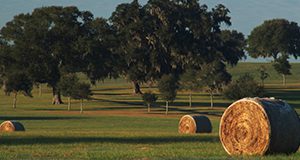The dimensions of large round bales make a difference in many cases. Bale size determines the amount of hay in a purchased bale, the amount of nutrients in pounds, and the extent of spoilage during storage and feeding. Large round bales, the predominant form of hay made and fed to cattle, are under discussion. This 3-page fact sheet is a new document that examines the significance of bale dimensions, volume, density, and weight as well as the relationship of these factors to hay prices. Written by Matt Hersom, Todd Thrift, and Joel Yelich, and published by the UF Department of Animal Sciences, June 2016.
http://edis.ifas.ufl.edu/an326
Tag: Joel Yelich
How the Veterinary Feed Directive Affects Cattle Owners
The Veterinary Feed Directive is a federal regulation from the Food and Drug Administration that will change the additives that can be included in animal feed, the ways in which cattle producers manage their animals and veterinarians interact with cattle owners, and the products available for use on the ranch. This 3-page fact sheet provides an overview of the new regulation’s nature, functions, requirements, and implications for cattle owners. Written by Matt Hersom, Todd Thrift, and Joel Yelich, and published by the UF Department of Animal Sciences, July 2016.
http://edis.ifas.ufl.edu/an327
Culling and Replacement Rate in the Beef Cow Herd
 Culling decisions are important to maintain the productivity and profitability of the beef cow herd. Culling of cows from the herd eliminates poorly performing cows, inferior genetics, and cows with quality defects that would limit short- and long-term productivity. This 4-page fact sheet discusses reasons to cull as well as replacement of culled cows. Written by Matt Hersom, Todd Thrift, and Joel Yelich, and published by the UF Department of Animal Sciences, December 2015.
Culling decisions are important to maintain the productivity and profitability of the beef cow herd. Culling of cows from the herd eliminates poorly performing cows, inferior genetics, and cows with quality defects that would limit short- and long-term productivity. This 4-page fact sheet discusses reasons to cull as well as replacement of culled cows. Written by Matt Hersom, Todd Thrift, and Joel Yelich, and published by the UF Department of Animal Sciences, December 2015.
http://edis.ifas.ufl.edu/an323
Shrink in Beef Cattle: A Marketing Consideration
 Shrink in beef cattle is weight loss that occurs between an animal’s departure from one location and weigh-in at another. Shrink in beef calves constitutes a potential economic loss to both the seller and the buyer if it is not fully considered. This 3-page fact sheet discusses factors that affect shrink and the effects of shrink on calf price. Written by Matt Hersom, Todd Thrift, and Joel Yelich, and published by the UF Department of Animal Sciences, December 2015.
Shrink in beef cattle is weight loss that occurs between an animal’s departure from one location and weigh-in at another. Shrink in beef calves constitutes a potential economic loss to both the seller and the buyer if it is not fully considered. This 3-page fact sheet discusses factors that affect shrink and the effects of shrink on calf price. Written by Matt Hersom, Todd Thrift, and Joel Yelich, and published by the UF Department of Animal Sciences, December 2015.
http://edis.ifas.ufl.edu/an322
Implications of Cow Body Condition Score on Productivity
Body condition score (BCS) indicates how much fat a cow has on its body, which is an important factor in cow health and reproductive capacity. Growers can use BCS to understand and manage the health of a herd and maintain a profitable operation. This 6-page fact sheet explains how BCS is measured, what different scores mean, the economic impact of various scores, and how changing cow nutrition can move BCS in a desired direction. Written by Matt Hersom, Todd Thrift, and Joel Yelich, and published by the UF Department of Animal Sciences, September 2015.
http://edis.ifas.ufl.edu/an319
Cull Cow Beef Quality Issues series
 Cull cattle are those that are sold from a herd for lack of performance, lack of resources, or genetic improvement The non-fed beef cattle market (cattle that are not managed through traditional feedlot finishing systems) is comprised primarily of cull cows and bulls. To address liability and food safety concerns, this series of articles discusses some quality defects identified in the non-fed beef market, how to prevent them, and how to address them when they appear in cattle.
Cull cattle are those that are sold from a herd for lack of performance, lack of resources, or genetic improvement The non-fed beef cattle market (cattle that are not managed through traditional feedlot finishing systems) is comprised primarily of cull cows and bulls. To address liability and food safety concerns, this series of articles discusses some quality defects identified in the non-fed beef market, how to prevent them, and how to address them when they appear in cattle.
- Overview of Cull Cow Beef Quality Issues
- Injection Sites and Abscesses
- Horns, Ocular Squamous Cell Carcinoma, and Lumpy Jaw
- Bruising, Condemnation, and Foreign Objects
- Cow Condition and Muscling
- Hide Defects, Contamination, and Non-Ambulatory Cattle
http://edis.ifas.ufl.edu/topic_series_cull_cow_beef_quality_issues
Effect of Age at Castration on Beef Calf Performance (AN289)
 A study in Florida was conducted to examine the issue of age at castration to determine if castration timing resulted in significant differences in growth rate and weaning weight in nursing calves. In addition, the study included a comparison between Angus and Brangus calves in the treatment groups to determine if there was a breed by castration effect. No differences in calf growth rates were observed in early compared to late castration. This 4-page fact sheet was written by Amie Imler, Todd Thrift, Matt Hersom, and Joel Yelich, and published by the UF Department of Animal Sciences, March 2013.
A study in Florida was conducted to examine the issue of age at castration to determine if castration timing resulted in significant differences in growth rate and weaning weight in nursing calves. In addition, the study included a comparison between Angus and Brangus calves in the treatment groups to determine if there was a breed by castration effect. No differences in calf growth rates were observed in early compared to late castration. This 4-page fact sheet was written by Amie Imler, Todd Thrift, Matt Hersom, and Joel Yelich, and published by the UF Department of Animal Sciences, March 2013.
http://edis.ifas.ufl.edu/an289
Comparison of Hay or Round Bale Silage as a Means to Conserve Forage (AN266)
 Florida’s climate makes conserving forages for later feeding challenging. Traditional hay harvest systems require optimal cutting, drying, and baling weather conditions. The use of round bale silage overcomes several of the challenges to hay production in Florida and offer an attractive compliment to traditional hay harvest systems. Learn more in this 6-page fact sheet written by Matt Hersom, Todd Thrift, and Joel Yelich, and published by the UF Department of Animal Science, August 2011. (Photo: Thomas Wright, UF/IFAS)
Florida’s climate makes conserving forages for later feeding challenging. Traditional hay harvest systems require optimal cutting, drying, and baling weather conditions. The use of round bale silage overcomes several of the challenges to hay production in Florida and offer an attractive compliment to traditional hay harvest systems. Learn more in this 6-page fact sheet written by Matt Hersom, Todd Thrift, and Joel Yelich, and published by the UF Department of Animal Science, August 2011. (Photo: Thomas Wright, UF/IFAS)
http://edis.ifas.ufl.edu/an266
The Impact of Production Technologies Used in the Beef Cattle Industry (AN272)
 The use of technologies in the beef industry is a major contributor to the safe, wholesome, and affordable beef supply in the United States. This 4-page fact sheet provides a brief evaluation of the effects that individual technologies have on beef production. Written by Matt Hersom, Todd Thrift, and Joel Yelich , and published by the UF Department of Animal Science, September 2011.
The use of technologies in the beef industry is a major contributor to the safe, wholesome, and affordable beef supply in the United States. This 4-page fact sheet provides a brief evaluation of the effects that individual technologies have on beef production. Written by Matt Hersom, Todd Thrift, and Joel Yelich , and published by the UF Department of Animal Science, September 2011.
http://edis.ifas.ufl.edu/an272
Preconditioning Calves Using Co-products (AN260)
Preconditioning cattle is a way to add value to a calf crop. It involves weaning, vaccination, and acclimating cattle to eating from feed bunks. This publication will focus on the nutrition, feedstuff considerations, and performance potential for different co-product options in preconditioning management. This 8-page fact sheet was written by Matt Hersom, Todd Thrift, and Joel Yelich , and published by the UF Department of Animal Science, May 2011.
http://edis.ifas.ufl.edu/an260
AN241 Wet Brewers Grains for Beef Cattle
AN241, a 4-page fact sheet by Megan Thomas, Matt Hersom, Todd Thrift, and Joel Yelich, describes this by-product of the beer-brewing industry — feed characterstics, considerations for use, and feeding guidelines. Includes references. Published by the UF Department of Animal Sciences, May 2010.
http://edis.ifas.ufl.edu/an241
AN238 What Does It Cost to Develop a Replacement Heifer?
AN238, a 3-page fact sheet by Matt Hersom, Todd Thrift, and Joel Yelich, highlights the important considerations, requirements, and inputs for developing a replacement heifer. Published by the UF Department of Animal Sciences, April 2010.
http://edis.ifas.ufl.edu/an238


